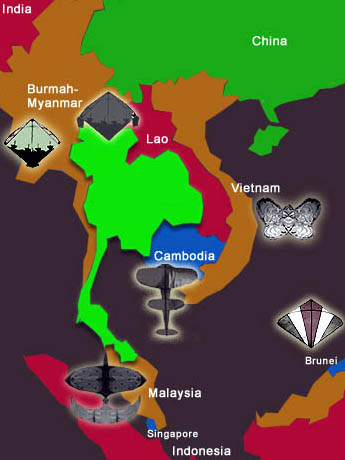Success Story in Cambodia
After its total suppression by the
Khmer Rouge, kiting has made a resounding comeback in Cambodia.
Last year a national kite museum was opened in the capital
Phnom Penh with His Excellency Ouk Socheat, undersecretary
of state for culture, presiding. Educational workshops for
children at the museum were initiated and judged a great success.
School tours of the facility began. And an annual kite festival
bloomed with 80 enthusiastic participants.
This kite activity parallels the revival of other unique Cambodian
cultural manifestations such as Khmer royal dance and the
country’s classic cuisine. All were victims of the Khmer
Rouge, whose infamous Maoist rule from 1975-79 caused 1.7
million deaths in the small country, including most members
of the educated classes.
The major .gure in the return of kiting as not only a sport
but also an important symbol of Cambodian cultural identity
is Sim Sarak, director general for administration of the Cambodian
Ministry of Culture and Arts. Sim was an enthusiastic .ier
as a boy and never forgot this early fascination. He has been
greatly aided by his wife Tcheang Yarin.
Another landmark in the resurgence of kiting in the Southeast
Asian nation was the recent publication------in Khmer, French,
and English------of a scholarly book on Cambodian kites. This
excellent, well illustrated work was written jointly by Sim
and Tcheang, both of whom know English and French. The English-language
version of the volume was supported by the Drachen Foundation.
Drachen has also given funds to the museum for educational
purposes, such as workshops and the purchase of a computer,
copier, and other useful equipment.
Ali Fujino, administrator of Drachen, worked with the Cambodians
and pronounces the joint, wide-ranging project successful
beyond her hopes. “They’re total stars,” she
says of the Cambodian group. “They had a goal and a focus
and they carefully orchestrated the project from start to
.nish. Their collaboration with each other and with Drachen
was exemplary. Able people in the .eld completed tasks assigned
them. There was no deviation. This was a case of nationals
doing it on their own, and doing it well. As the leaders,
Sarak and Yarin had the passion, not uncommon in third world
countries, but also the skills, often lacking, to complete
a grand plan. They and their group have my deepest respect.”
|
|
about Khmer Kite Culture:
and Interview with Sim Sarak, from Leisurecambodia
Magazine January, 2002 Volume 2 No.1
For Khmers, Kites Mean Peace
By :
Ann Creevey, Picture by : Nathan Dexter.
One is washing the oil and grease from his hands. The others,
Sim Sarak and his wife Chieng Yarin, dressed smartly, look
somehow out of place next to Krong Nguon Ly's busy mechanics
workshop. But their passion is the same. All are dedicated
to the Cambodian musical kite, the kleng-ek, which would have
died out along with so much of Cambodia's culture if it wasn't
for the dedication of these few. Particularly Sim Sarak's.
The Director General of Administration and Finance at the
Ministry of Culture and Fine Arts learned to love these special
kites as a boy in Kampong Cham Province. The kite was in decline
even before the Khmer Rouge regime came to power.
Once an important symbol of the end of rainy season, the last
king to entertain a passion for kites was King Angduong. When
he died in 1859, people stopped making kleng-ek as much as
before. In Khmer folklore, kites have always been a symbol
of freedom.
Legend has it that, many centuries ago, a Khmer man was imprisoned
by a cruel
Chinese king and locked in a tower. He used his time to create
a kite, and the noise it made when he flew it from the window
of his cell so frightened the king that he ordered him released.
A butterfly kite, a lantern kite and (right) the magnificent
kleng-ek. All are traditional Khmer kites, but the kleng-ek
is unique.
"I was always fascinated by the kleng-ek especially,
with its beautiful sound. The kleng-ek is the only truly musical
kite in the world-a great kite maker can get seven different
tones out of the musical bow," Sim Sarak, now 52, explained.
Growing up nearby in the same province, Krong Nguon Ly, now
45, learned how to make kleng-ek from his father.
Kleng-ek are huge kites, sometimes more than a meter long
and a meter wide. They do not transport easily and few dedicated
kite makers will scale down their models to make them more
attractive to overseas buyers.
"Any smaller and they are much less stable. You cannot
really do that," Krong Nguon Ly explained.
"If we need to transport them, we dismantle them and
reassemble them when we get where we are going. I can sell
one of my kites for $70 to $100 overseas, but I am a mechanic.
I don't have time to make kleng-ek for sale. There isn't enough
money in it. I do it for love."
In the old days, kleng-ek were made of silk cloth.
Now, most kite makers can only afford brown paper such as
the type used to pack cement, but despite this, the elegant
curves and sheer size of these unique kites means they are
still beautiful works of art, and one kite will take its maker
weeks to perfect.
The bow at the front is what makes the noise a low, distinct
humming that makes the kite seem like it is singing. This
is called the ek. The bow is usually fashioned from bamboo,
and a fine strip of bamboo or rattan is strung tightly across
the top, giving the kite its distinctive appearance.
Perhaps because people had so little freedom and lived in
such fear during the Khmer Rouge regime, both Sim Sarak and
Krong Nguon Ly returned to Phnom Penh after the fall of the
Khmer Rouge with an aching desire to resurrect the ancient
art.
"When I returned to the city in 1979, the first thing
I saw were children flying makeshift kites," Krong Nguon
Ly said.
"That's when I knew that kites and freedom are the same
thing. Without kites, there is no peace. Without peace, we
have no kites."
Kites are traditionally flown to mark the end of wet season
and the beginning of harvest season.
"Traditional Khmers will never fly a kite before Water
Festival (in November)," Sim Sarak explained.
"That would be bad luck. There is a time for everything,
and that includes kites."
Kites must not be flown after February. So for nine long months,
lovers of the kleng-ek must wait and watch over their kites
in their homes before they can fly them once more.
The two passionate kite makers eventually met when Sim Sarak
made his dream come true.
In 1996, he organized the first National Kite Flying Competition.
Krong Nguon Ly came second, but the two became friends across
the wings of kites.
Now the kite competition is an annual event, and various traditional
kites besides the kleng-ek also compete-butterfly kites, lantern
kites and moon kites.
But for Sim Sarak, the kleng-ek is the greatest of the kites.
It is the one he and Krong Nguon Ly take to Dieppe, France,
for one of the world's top annual kite flying events.
"He is the father of modern kite makers in Cambodia,"
Sim Sarak's wife Chieng Yarin said proudly. "Without
him, there may not be any kites any more."
"I am proud to have helped save a tiny piece of Khmer
culture. I do it for love," Sim Sarak said.
|
|
[ from IOL
/ reuters - August 20 1999 ]
Killjoy Cambodians stamp out kite-flying
Phnom Penh - Cambodian authorities
have cracked down hard on a new social menace - children flying
kites in city parks.
The pastime is hard on the grass, authorities said.
So police - some of them armed - have been chasing children
away from parks in the capital and confiscating kites from
vendors in a heavy-handed blitz on the flyers, the Phnom Penh
Post reported on Friday.
"We cannot even let two or three people play with kites
in the park because then there will suddenly be 100 or 200
people flying kites, too," one security guard told the
newspaper.
Flocks of colourful kites, their tails streaming in rainy
season breezes, have been flying over the city in recent weeks.
"Cambodians love to fly kites because they look so pretty
in the sky," said one kite vendor. "And it makes
them relax because it has nothing to do with politics."
But city officials said the kite flyers were damaging the
grass and posing a traffic hazard.
|

